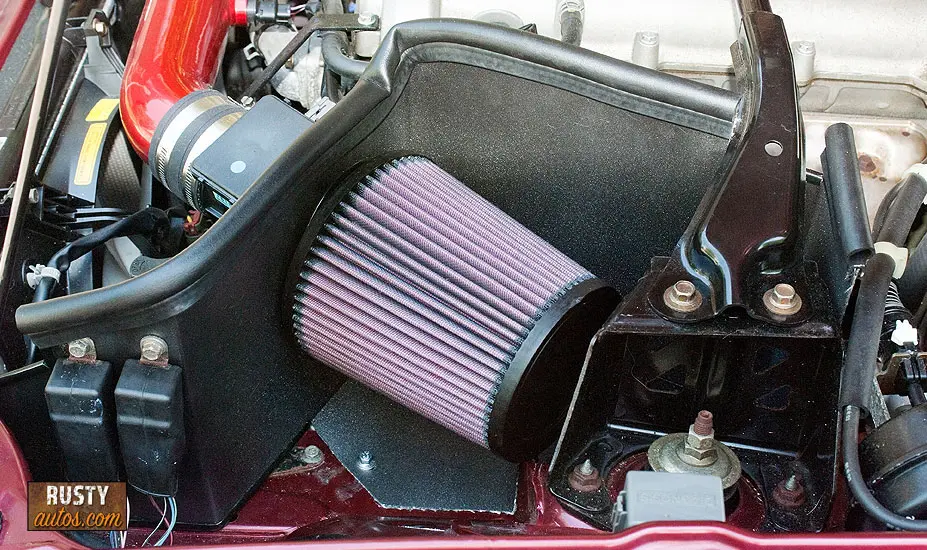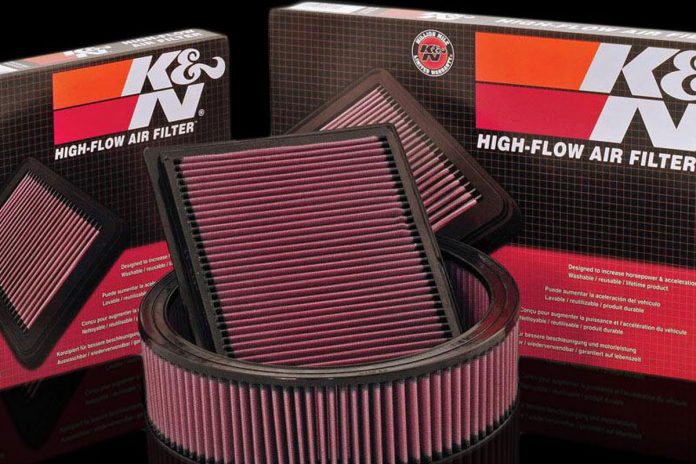I love engines, been around them all my life, motorbikes, cars, and trucks. Wanting more power is normal but cost, skills and time often take a P*** on the plans. That’s the magic of performance air filters, they are cheap, easy to fit, and most importantly, they make more smiles.
Fitting a K&N high flow air filter is the easiest, most cost-effective, and least technical way of increasing engine performance. K&N filters are worth it, they’re reusable and come with a 10 year or one million-mile warranty.
In this post you’ll learn why this mechanic likes K&N filters, you’ll learn how to fit a filter, how and when to clean and oil a K&N filter.
The Need For More Power
There are many ways to increase how quickly a machine moves down the road. However, as said, cost, lack of mechanical skills, and time are for most, limiting factors. A racing team has a budget of millions to throw at engineering challenges. The average car owner must work within tight parameters.
When I got my first car, I was like all my friends, obsessed with power and speed. Not having a ton of resources (money or skills) I had to resort to some pretty drastic measures. I attacked the problem from the other side, making the car lighter. I’d remove a ton of components, you know all the comfort stuff, door cards, carpets, insulation, rear seats. And it works, but it’s not practical.
The solution is obvious then, if we want more power, we’ll have to make it. There are a few common and relatively inexpensive ways to go about this:
- Intake – Fit performance intake system
- Exhaust – fitting a performance exhaust system allows spent gasses leave the engine faster
- Remapping – reprograming the ECM (Engine Control Module) also known as the ECU, PCM
Air in is super important, as that’s where the power-making process begins.
Why Is Air So Important?
An engine won’t run on gas alone, it needs air (oxygen), and since fire can’t exist without the presence of oxygen, air and gas are equally important. Not only that, the ratio of air to gas is important. And that ratio is 14.7: 1 – that’s fourteen point seven parts oxygen to one part gas, it’s the optimum ratio for performance. It’s known as the AFR (Air Fuel Ratio).
Modern cars employ a MAF (Mass Air Flow) sensor to measure air volume entering the engine. Based on this measurement, the ECU makes a calculation and adds the correct volume of gas.
The concept is simple – more air in equals more power out. It really is that simple and that’s why upgrading an engine’s air filter is the easiest and most cost-effective modification an owner can make.
Why Are Air Filters So Important?
So if more air makes more power, wouldn’t removing the filter altogether increase horsepower? Yes, you are correct it would and many do exactly that. However, that comes with some pretty horrible consequences, especially in dusty conditions.
The filter’s job is to prevent small particles of dust enter the engine. Dust contains Silica, which is small hard rock particles, and if allowed, would happily sandblast the intake system as your engine sucks air.
In addition, dust will contaminate the oil and make its way throughout the engine which will shorten the life of the motor.
Many car engines are fitted with turbochargers. While durable, they are extremely sensitive to poor oil quality and unfiltered air. Debris will erode the turbos alloy impeller and larger debris will break and deform it, causing an imbalance and failure.
A turbo that spins at over 200,000 rpm needs to be kept cool, contaminated oil will cause bearing and seal failure pretty quickly.
Modern cars house the MAF sensor inside the intake ………. after the air filter and so is protected from dirt and debris. Running without the filter, therefore, allow dirt to contaminate and damage the sensor likely causing incorrect air flow readings which as you know is vital for fuel ratio calculations.
But a filter does more than prevent fine particles enter the engine. It prevents large objects enter the motor. Larger items have been known to enter the engine causing catastrophic damage. Items like small tools, nuts, bolts, screws, stones can easily be sucked into an unprotected intake system.
A filter offers protection to water ingestion, a common cause of hydro locking which often ends with a destroyed motor. Hydro locking is common in wetter climates where there’s a ton of standing water, the driver hits the water and it’s sucked into the cylinder. As water isn’t compressible, the conrod usually bends which is spendy to fix.
An air filter won’t eliminate the hydro locking but will certainly reduce the risks.
An air filter helps to settle air into a more uniform shape rather than have air hit the AF sensor in large chunks, this obviously makes for a more consistent fueling.
Why Are K&N Filters So Good?

Many of the best products and services are born out of necessity and that’s true for K&N. K and N, are the initials of the founders, Ken Johnson and Norm McDonald. Back in the ’60s, the duo was frustrated by constantly clogging paper air filters on their racing bikes. They set about solving the problem, they did that and more.
They found paper used in the filters was a big part of the problem, paper is great for filtration but bad for airflow. Most air filters are designed as throw-away items, they’re made cheaply.
K&N took a different approach. They use between four and six layers of natural cotton pleated over a mesh frame. The cotton allows for much greater airflow than paper, more air however does risk allowing contaminates in, but K&N has it covered, they use their secret sauce – filter oil.
The tacky oil is specially formulated to capture microscopic levels of dust without causing restriction. With this breakthrough, K&N filters offer high flow unrestricted air without risking oil contamination, MAF sensor, turbo, or intake system damage.
K&N now builds air filters in California for all types of machines. Their filters are recognized and trusted by high-performance racing teams in NASCAR, and many other apex motorsports.
So what’s so good about K&N, here’s why mechanics, racers, and DIY tuners love them:
Power
More air equals more power, and K&N oversized high-flow filters will allow greater airflow. While replacing just the OEM air filter with a K&N high flow filter will add horsepower and increase acceleration, the biggest gains are to be had by fitting a complete cold air intake system.
What’s a cold air intake system? It’s a complete system built around a core focus, allowing your engine to make more power.
This cold air intake system solves a few common problems with stock intake systems. The restrictive paper filter you already know about. The tubing is often narrow and doesn’t take the shortest route, narrow longer tubing is slower. And the third common problem, hot air contamination – hot air from the motor is ingested through the air filter. On a cold start, that’s not a bad thing, but as an engine warms up, hot air is a drag on power.
Hot air isn’t as dense in oxygen as cold air and as you remember, air to fuel ratio is really important when it comes to making horses. The more cold oxygen-rich air we stuff in the engine, the more power we can make.
To solve these challenges K&N offers the cold air intake system designed to offer air a shorter route through fatter, shorter tubing. It includes a large cotton conical filter and it’s fitted inside a sealed cold air box.
The box is sealed and keeps the heat from the motor away from the intake, some systems may include an intake dam to ram the cold air in.
So what kind of power can you expect? Depending on the motor, K&N guarantees a power improvement though, and many motors see between 10 – 15 horsepower improvements with complete cold air intake system kits. K&N tested a Shelby GT500 and achieved over 50 HP with just such a system.
Construction
K&N filters are designed to be reused. They don’t use paper like most other filter makers. Their filters are long life, designed to go the distance, one million miles actually, guaranteed by K&N.
They use between four and six cotton gauze layers pleated around a mesh frame to build the filter media. The cotton is woven tightly or loosely depending on the filter application.
The tubing is premium quality too, depending on the vehicle, the two common materials are molded Polyethylene or mandrel-bent aluminum. Mandrel-bent is a more costly and time-consuming method of bending tubing, but using a mandrel to bend tubing doesn’t cause wrinkling on the inside bends. And that’s important, wrinkles cause airflow restrictions which upsets the airflow.
The nice people at K&N won’t tolerate wrinkles.
Easy fitting
As a mechanic, I have a ton of experience fitting intake systems. And yes I do earn a small fee if you buy your K&N filter through the link on this page. But truthfully, you can’t buy an easier-fitting cold air intake system kit.
I’ve fitted a ton to Silverado trucks and Camaros, they are a pleasure to fit. Just some basic tools and about an hour usually does the job. I cover the process below in more detail.
You can tell a quality product in many ways and as an experienced mechanic, one of them – is how many cuts you gather fitting the kit. It’s a sign of how much pride they take with the dressing sharp edges of plastic and metal tubing and shield etc.
Look
K&N offers polyethylene, polished aluminum, coated aluminum in a ton of different colors. You can go for the stock or custom look.
The trademark red filter (commonly conical in shape) on show or your kit may include an enclosed air box. That said, K&N has released the new Black Hawk filter which is black and non-oiled.
Sound
The larger air filter and tubing do offer a deeper throatier sound when accelerating. It’s noticeably louder but it’s not a drone.
Reuseable
K&N filters are designed to be reused which is kinder to your pocket and to the environment.
Warranty
The filters are built using top-quality materials and in such a way that K&N will guarantee their flawless performance for ten years or one million miles, it’s impressive.
Check out the Amazon link below for great deals on K&N filters.
Fitting as said is easy, the instructions are laid out in numbered steps and detailed for your vehicle. The instructions include removing the stock intake.
Obviously makes and models will differ slightly but the workflow is similar. Set aside about an hour and a half, although about an hour should do the job. Any handyman-type toolbox will contain the type of tools you’ll need.
I will say some kits may require drilling a hole or two. Most however will utilize all the original mounting points of the airbox and tubing support brackets.
Here’s a list of the type tools:
- Torx set
- Hex set
- Screwdriver flat and Philips
- 8 mm driver or socket and ratchet with long extension
- Drill
Before fitting, check the instructions twice, we all miss details on the first read. Layout all the components to have a feel for the job at hand. Obviously, a flat, sealed floor in a well-lit area is best, stuff falls, it happens, this type of environment allows you to recover quickly.
Much of the new intake assembly may be done at a bench and then offered to the engine.
The fitting process looks something like this:
- Remove engine cover
- Remove air box cover and filter
- Remove tubing securing fasteners
- Loosen tubing clamp at the throttle body
- Remove MAF sensor terminal connector
- Remove crank case breather pipe
- Remove tubing and set aside
- Remove air box fasteners and remove air box
At a workbench assemble as per the stepped procedure in the instructions. A typical assembly will look something like this:
- Add filter mount to the heat shield using fasteners provided
- Fit weather stripping to the heat shield
- Fit clamp to silicone coupler and fit coupler to filter mount
- Tighten the 8 mm coupler clamp
New intake assembly is almost ready for fitting, and that process looks like this:
- Fit the remaining silicone coupler to the engines throttle body and tighten the 8 mm clamp
- Remove the MAF sensor from old tubing
- Fit the MAF to the new tubing
- Offer the heat shield to the chassis mounting points and secure
- Fit both clamps to the tubing and off the tubing to the throttle body and fit loosely
- Fit MAF sensor terminal connector
- Fit crank case breather pipe
- Fit new K&N filter
- Now make any adjustments to the lay out of the tubing before snugging up all clamp fasteners
- Refit engine cover
Store the old intake system carefully, you may need it in the future. A garage may ask for the original intake system when part exchanging your vehicle.
To successfully clean a K&N filter you’ll need K&N’s Power clean, and after the cleaning, the filer will need to be oiled. That of course means using specialized K&N air filter oil. The best option here is to go ahead and buy what K&N calls the Recharge and service kit, it’s cleaner and oil.
The whole process looks like this:
- Remove the filter
- Spray the filter with the K&N’s Power cleaner both sides and allow sit for ten minutes or so (not in the sun)
- Using a suitable catch and a garden hose, rinse the filter (from filtered side to intake side) until water runs clean (do not use pressure washer)
Shake the filter dry and allow to air dry (Do not use compressed air)
After the filter has dried, it’s time to oil it, the process is as follows:
- Apply an even spray coat of oil to the intake side of the filter
- Reapply to the areas that look paler in color
That’s it you are good to fit the filter, and check it again in six months’ time or more often if you’re running in a dusty environment.
Can you wash K&N with soap and water?
While it is possible to wash a K&N filter in soap and water, it’ won’t offer a complete clean. Using a K&N Power clean is a better option, alternatively, buy the Recharge and service kit which includes cleaner and specialized K&N air filter oil.
Can you use Wd40 on K&N filter?
Using WD40 on a K&N filter will not help the filter capture fine dust particles. K&N uses specialized oil for its air filters. The oil works hand in hand with the filter media to trap fine particles of dust and prevent component damage such as intake system erosion, turbo impellor impact, MAF sensor fouling, and engine oil contamination.




